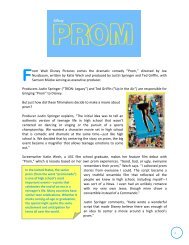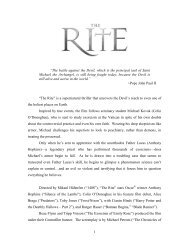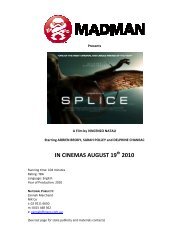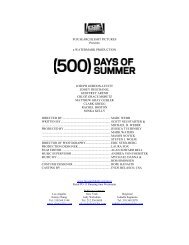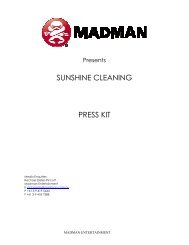about the cast - Thecia
about the cast - Thecia
about the cast - Thecia
You also want an ePaper? Increase the reach of your titles
YUMPU automatically turns print PDFs into web optimized ePapers that Google loves.
ourselves and our own responsibility . It is very emotional, both to people already aware of <strong>the</strong> ocean as well as those who feel very<br />
disconnected from it .”<br />
Says Brosnan: “I hope ‘Oceans’ will become a family favorite for many years to come and that, maybe, just a few or many, will be<br />
inspired to do good things…for our planet .”<br />
A GLOBAL AQUATIC ADVENTURE FINDS BOUNDLESS LIFE AT SEA<br />
Diversity Survives in <strong>the</strong> World’s Unspoiled Sanctuaries<br />
For four years, “Oceans’” camera crews lived beside <strong>the</strong> creatures of <strong>the</strong> sea from <strong>the</strong> tiniest krill to <strong>the</strong> mightiest cetaceans—and<br />
everything in between . From pole to pole, multiple film crews sought out places where life continues as it has for thousands of years, as<br />
well as sites where <strong>the</strong> natural order has changed due to human encroachment .<br />
“We found that in many places <strong>the</strong> sea life we were searching for no longer exists because of things like over-fishing, pollution and<br />
over-development,” says Cluzaud . “But we also found sanctuaries scattered here and<br />
<strong>the</strong>re where life can express itself naturally, and recover with tenacity and strength .<br />
These small, remote places give us <strong>the</strong> hope that <strong>the</strong>y are not a reflection of past<br />
diversity, but <strong>the</strong> expression of life, always renewable, wild and free .<br />
“Near Cocos Island off of Costa Rica, you only need to put your head under water<br />
to see fish of all sorts,” continues Cluzaud . “There are a variety of sharks, as well as all<br />
types of rays and tortoises and sea mammals . In <strong>the</strong> nor<strong>the</strong>rn Arctic, we went to <strong>the</strong><br />
small island of Coburg, where even our Inuit guides had never set foot, and we saw<br />
seals, walruses and polar bears still at home by <strong>the</strong>mselves . At <strong>the</strong> extreme west of<br />
<strong>the</strong> Galapagos Islands, which rarely sees more than one scientist in 20 years, eagles,<br />
sea iguanas, sea lions and cormorants fearlessly settled a few yards away to observe .”<br />
Multiple crews traveled <strong>the</strong> globe as production manager Olli Barbé juggled time zones and seasons at <strong>the</strong> film’s nerve center<br />
in Paris—Galatée Films French production studio . In some cases, crews returned to <strong>the</strong> same spots during <strong>the</strong> same season a year or<br />
more later to continue shooting . Perrin and Cluzaud accompanied crews to each location for <strong>the</strong> initial shoot to determine what kind of<br />
footage would be possible .<br />
“Nature is nei<strong>the</strong>r controllable nor predictable,” says Cluzaud . “Luckily, Jacques<br />
and I came to this without any idea of limits, including that of time . Time was <strong>the</strong><br />
most precious element that Jacques Perrin gave us by carrying <strong>the</strong> production on<br />
his shoulders . It was absolutely necessary to film images that allowed us to edit a<br />
sequence as rich and dynamic as we would do in a feature film . We needed to be able<br />
to start over and over again, whatever problems we encountered .”<br />
Their persistence was rewarded with visuals unlike any filmed before, including<br />
a unique shot of <strong>the</strong> blue whale, <strong>the</strong> largest creature ever known to have existed on<br />
Earth, feeding .<br />
“The blue whale is an almost mythical animal—furtive, rapid, discreet,” says<br />
Perrin . “And very, very big! It has almost never been filmed underwater and never, to our knowledge, while feeding . It took a great deal<br />
of time to successfully film <strong>the</strong> blue whale gulping down a cloud of krill .<br />
“To be exact, it was 28 weeks of patience,” he says . “Imagine 190 days of<br />
scrutinizing <strong>the</strong> sea, seeking krill schools and blue whales from sunrise to sunset .<br />
Thousands of failures yielded <strong>the</strong>se extraordinary moments where we accompanied<br />
<strong>the</strong> whale into a cloud of krill . The success of <strong>the</strong> shots was thanks to <strong>the</strong> exceptional<br />
perseverance of American cameraman David Reichert .”<br />
Few people on Earth are as familiar with <strong>the</strong> sea as Dr . Sylvia Earle, Explorer-in-<br />
Residence at <strong>the</strong> National Geographic Society and scientific advisor for Disneynature .<br />
Often called <strong>the</strong> Jane Goodall of <strong>the</strong> ocean, Earle has been studying marine life up<br />
close since <strong>the</strong> 1950s, but “Oceans” was eye-opening even for this expert .<br />
“I have had <strong>the</strong> joy of spending thousands of hours swimming with fish,” says<br />
Earle . “The time I have spent in <strong>the</strong> sea has given me a different perspective . I try to get everybody I can to go diving, but as hard as I try,<br />
I know I’m not going to get everybody to go jump in <strong>the</strong> ocean . The next best thing is to see ‘Oceans .’ Even with all <strong>the</strong> diving that I’ve<br />
done, I’ve seen things in this film that I’ve never seen in life .”<br />
Earle has been diving in <strong>the</strong> Galapagos Islands since 1966, drawn by <strong>the</strong> wide variety of singular creatures that are native to <strong>the</strong> area,<br />
like <strong>the</strong> marine iguana . “The marine iguana eats seaweed,” she says . “It will dive down, holding its lizard breath, 30, 40, 50 feet beneath <strong>the</strong><br />
surface to chomp on <strong>the</strong> seaweed . Well, to see it even once is a heart-stopping event . But to see it <strong>the</strong> way it’s documented in ‘Oceans’ is a<br />
15



